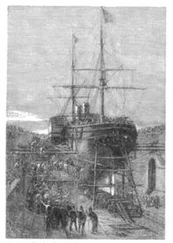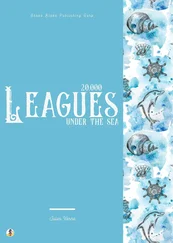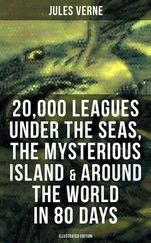An interminable debate then broke out between believers and skeptics in the scholarly societies and scientific journals. The “monster question” inflamed all minds. During this memorable campaign, journalists making a profession of science battled with those making a profession of wit, spilling waves of ink and some of them even two or three drops of blood, since they went from sea serpents to the most offensive personal remarks.
For six months the war seesawed. With inexhaustible zest, the popular press took potshots at feature articles from the Geographic Institute of Brazil, the Royal Academy of Science in Berlin, the British Association, the Smithsonian Institution in Washington, D.C., at discussions in The Indian Archipelago, in Cosmos published by Father Moigno, in Petermann’s Mittheilungen, and at scientific chronicles in the great French and foreign newspapers. When the monster’s detractors cited a saying by the botanist Linnaeus that “nature doesn’t make leaps,” witty writers in the popular periodicals parodied it, maintaining in essence that “nature doesn’t make lunatics,” and ordering their contemporaries never to give the lie to nature by believing in krakens, sea serpents, “Moby Dicks,” and other all-out efforts from drunken seamen. Finally, in a much-feared satirical journal, an article by its most popular columnist finished off the monster for good, spurning it in the style of Hippolytus repulsing the amorous advances of his stepmother Phædra, and giving the creature its quietus amid a universal burst of laughter. Wit had defeated science.
During the first months of the year 1867, the question seemed to be buried, and it didn’t seem due for resurrection, when new facts were brought to the public’s attention. But now it was no longer an issue of a scientific problem to be solved, but a quite real and serious danger to be avoided. The question took an entirely new turn. The monster again became an islet, rock, or reef, but a runaway reef, unfixed and elusive.
On March 5, 1867, the Moravian from the Montreal Ocean Co., lying during the night in latitude 27° 30’ and longitude 72° 15’, ran its starboard quarter afoul of a rock marked on no charts of these waterways. Under the combined efforts of wind and 400-horsepower steam, it was traveling at a speed of thirteen knots. Without the high quality of its hull, the Moravian would surely have split open from this collision and gone down together with those 237 passengers it was bringing back from Canada.
This accident happened around five o’clock in the morning, just as day was beginning to break. The officers on watch rushed to the craft’s stern. They examined the ocean with the most scrupulous care. They saw nothing except a strong eddy breaking three cable lengths out, as if those sheets of water had been violently churned. The site’s exact bearings were taken, and the Moravian continued on course apparently undamaged. Had it run afoul of an underwater rock or the wreckage of some enormous derelict ship? They were unable to say. But when they examined its undersides in the service yard, they discovered that part of its keel had been smashed.
This occurrence, extremely serious in itself, might perhaps have been forgotten like so many others, if three weeks later it hadn’t been reenacted under identical conditions. Only, thanks to the nationality of the ship victimized by this new ramming, and thanks to the reputation of the company to which this ship belonged, the event caused an immense uproar.
No one is unaware of the name of that famous English shipowner, Cunard. In 1840 this shrewd industrialist founded a postal service between Liverpool and Halifax, featuring three wooden ships with 400-horsepower paddle wheels and a burden of 1,162 metric tons. Eight years later, the company’s assets were increased by four 650-horsepower ships at 1,820 metric tons, and in two more years, by two other vessels of still greater power and tonnage. In 1853 the Cunard Co., whose mail-carrying charter had just been renewed, successively added to its assets the Arabia, the Persia, the China, the Scotia, the Java, and the Russia, all ships of top speed and, after the Great Eastern, the biggest ever to plow the seas. So in 1867 this company owned twelve ships, eight with paddle wheels and four with propellers.
If I give these highly condensed details, it is so everyone can fully understand the importance of this maritime transportation company, known the world over for its shrewd management. No transoceanic navigational undertaking has been conducted with more ability, no business dealings have been crowned with greater success. In twenty-six years Cunard ships have made 2,000 Atlantic crossings without so much as a voyage canceled, a delay recorded, a man, a craft, or even a letter lost. Accordingly, despite strong competition from France, passengers still choose the Cunard line in preference to all others, as can be seen in a recent survey of official documents. Given this, no one will be astonished at the uproar provoked by this accident involving one of its finest steamers.
On April 13, 1867, with a smooth sea and a moderate breeze, the Scotia lay in longitude 15° 12’ and latitude 45° 37’. It was traveling at a speed of 13.43 knots under the thrust of its 1,000-horsepower engines. Its paddle wheels were churning the sea with perfect steadiness. It was then drawing 6.7 meters of water and displacing 6,624 cubic meters.
At 4:17 in the afternoon, during a high tea for passengers gathered in the main lounge, a collision occurred, scarcely noticeable on the whole, affecting the Scotia’s hull in that quarter a little astern of its port paddle wheel.
The Scotia hadn’t run afoul of something, it had been fouled, and by a cutting or perforating instrument rather than a blunt one. This encounter seemed so minor that nobody on board would have been disturbed by it, had it not been for the shouts of crewmen in the hold, who climbed on deck yelling: “We’re sinking! We’re sinking!”
At first the passengers were quite frightened, but Captain Anderson hastened to reassure them. In fact, there could be no immediate danger. Divided into seven compartments by watertight bulkheads, the Scotia could brave any leak with impunity.
Captain Anderson immediately made his way into the hold. He discovered that the fifth compartment had been invaded by the sea, and the speed of this invasion proved that the leak was considerable. Fortunately this compartment didn’t contain the boilers, because their furnaces would have been abruptly extinguished.
Captain Anderson called an immediate halt, and one of his sailors dived down to assess the damage. Within moments they had located a hole two meters in width on the steamer’s underside. Such a leak could not be patched, and with its paddle wheels half swamped, the Scotia had no choice but to continue its voyage. By then it lay 300 miles from Cape Clear, and after three days of delay that filled Liverpool with acute anxiety, it entered the company docks.
The engineers then proceeded to inspect the Scotia, which had been put in dry dock. They couldn’t believe their eyes. Two and a half meters below its waterline, there gaped a symmetrical gash in the shape of an isosceles triangle. This breach in the sheet iron was so perfectly formed, no punch could have done a cleaner job of it. Consequently, it must have been produced by a perforating tool of uncommon toughness—plus, after being launched with prodigious power and then piercing four centimeters of sheet iron, this tool had needed to withdraw itself by a backward motion truly inexplicable.
This was the last straw, and it resulted in arousing public passions all over again. Indeed, from this moment on, any maritime casualty without an established cause was charged to the monster’s account. This outrageous animal had to shoulder responsibility for all derelict vessels, whose numbers are unfortunately considerable, since out of those 3,000 ships whose losses are recorded annually at the marine insurance bureau, the figure for steam or sailing ships supposedly lost with all hands, in the absence of any news, amounts to at least 200!
Читать дальше












